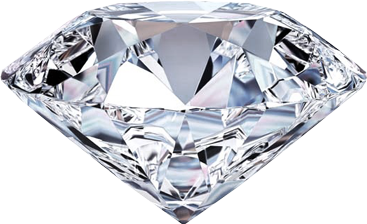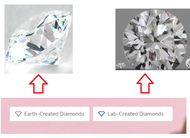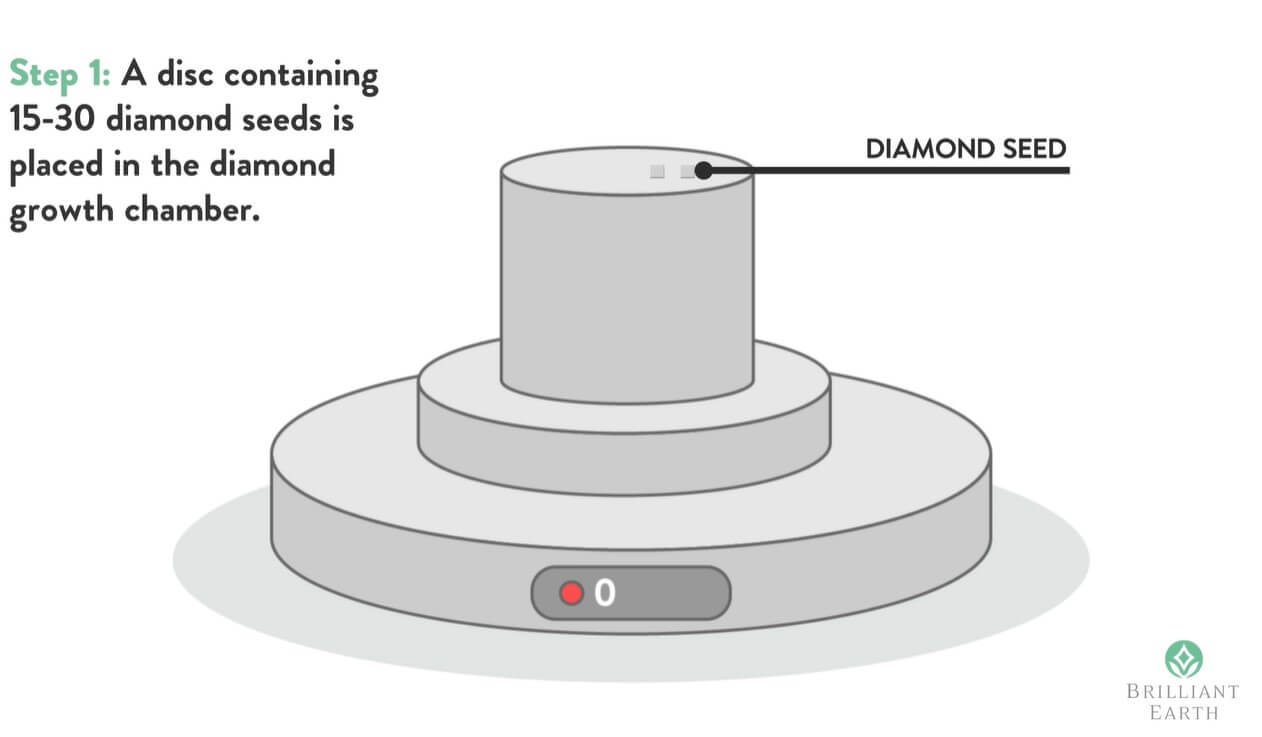Lab vs. Natural Real Diamonds: What is the Difference?
Lab vs. Natural Real Diamonds: What is the Difference?
Posted by Sharif Khan on 25th Jan 2023
Lab-Grown vs. Natural Diamonds

Demand for lab-created diamonds is growing. They have similar physical and chemical characteristics as natural diamonds and are grown in a lab from the seed of a natural diamond.
On one side, miners and traders of natural diamonds are concerned that lab-grown diamonds might take them out of business; on the other hand, enthusiasts of these synthetic diamonds believe that these stones are ethically sourced and do not negatively impact the environment—a debatable assertion. On top of that, lab diamonds are also significantly cheaper compared to natural diamonds.
Our key conclusion is that lab-grown diamonds are now a new product category in the gem and jewelry industry. Similarly, natural diamonds will continue to have a high demand for what they indeed are – unique precious gemstones. Comparing one to the other or thinking of lab-grown diamonds as an alternative to natural diamonds is not the best way to approach this issue. Instead, it might be more helpful to consider each option under your unique circumstances, use case, and budget.
Search and watch lab-grown diamonds in 40X MAGNIFIED VIDEOS.
Key Points to Know
- Jewelers and regular buyers cannot tell the difference between lab and natural diamonds with a physical inspection. However, now we have access to special tools to verify a natural diamond.
- While lab diamonds are a good addition to the market, they are not an alternative to natural diamonds.
- They are a good option for fashion jewelry, budget shoppers, and individuals in the market who are looking for a fancy color diamond at an affordable price.
- Lab-created diamonds are less likely to hold any future resale value.
Five Arguments in Support of Natural Diamonds
- Geological Wonders: Natural diamonds are geological wonders with unique origin stories and characteristics.
- Long-Term Value: They hold better value over the long term.
- Support for Communities: They support mining communities and the entire supply chain of traders, artisans, and jewelers.
- Emotional Connection: Even if lab diamonds are chemically identical to their counterparts, gem enthusiasts have a different connection with natural diamonds.
- Environmental Sustainability: Environmental sustainability standards for curbing conflict diamonds have significantly improved over the years.
Lab vs. Natural Highlights
| Origin | Natural and lab-grown diamonds are two specimens of crystalized carbon. The mined ones are roughly 90 million to three billion years old, and the grown ones are created within weeks. In short, the key difference between the two is their origin. |
| Prices | While the prices of gem-quality natural diamonds are relatively stable, the prices of lab-created diamonds continue to fall as the technology for growing them becomes more efficient. On average, the prices of lab-grown diamonds have fallen by 65-75% since 2016. |
| Hardness | Lab and natural diamonds receive a hardness score of 10 on the MOHS scale with 100% SP3 carbon bonds. See more below. |
| Fancy Color | Because natural fancy color diamonds are rare and costly, fancy lab diamonds offer an excellent alternative for individuals who cannot afford natural fancy color diamonds. |
| Clarity | Natural forces created mined diamonds beneath the earth’s surface from pure carbon. During the growth process, other substances got trapped inside them. Lab diamonds also often have inclusions because their seeds are from natural diamonds. |
| HPHT vs. CVD |
Although research has been ongoing for decades to grow high-quality lab diamonds – at least since the 1950s; they recently became available in large quantities. Lab diamonds are grown using two primary methods: high pressure, high temperature (HPHT), and chemical vapor deposition (CVD). Learn more here about HPHT vs. CVD. |
| Detection | Traditional methods and detectors are insufficient to distinguish between lab-grown and natural diamonds. For example, GIA uses a unique iD100® screen to differentiate between lab-grown and natural diamonds. More tools are being developed to help retailers detect lab vs. natural diamonds. |
Lab vs. Natural: Price Differences
The price disparity between lab-grown and natural diamonds has grown. While lab diamonds are still difficult to grow, because the technology and techniques for manufacturing them have improved significantly, the cost of growing lab-made diamonds has decreased. Notably, since 1960, the prices of natural diamonds have increased by an average of 4.3 percent yearly.
It is important to note that reselling a mined or lab diamond for the same price is difficult. Lab diamonds are probably not a good choice if the value is a key consideration, as natural diamonds maintain better value. At the same time, lab diamonds can be an excellent option for saving money.
Example of Price Difference:
A 1 carat diamond in a simple platinum solitaire ring with E color and VS1 clarity would cost roughly $7,000 if it were a natural diamond. A lab-grown specimen would come in at around $800.
- 1.01 Carat Round Cut Natural Diamond - Price $6,300 (SEE EXAMPLE)
- 1.02 Carat Round Lab Diamond - Price $636 (see example)
Buyers will pay a markup on a new diamond, whether natural or lab-grown, especially after adding sales tax. This would also include a 20% jeweler’s markup. Additionally, when selling a diamond back to a jeweler, they want to buy it below the wholesale market price.
So, considering the above example, the loss would be roughly $2,000 for the mined diamond, which is more than the total price of the lab-made diamond. The resale price would be approximately $500 for the lab-grown diamond along with the ring. While this is a higher percentage loss, the actual loss is smaller.
Some individuals are okay with sacrificing the carat weight and buying a natural loose GIA certified diamond. For example, they might choose a 0.5 carat natural diamond instead of a 1 carat lab-made diamond for $1,000. In this case, selling the natural would save $700 compared to around $100 for the lab-made one. However, is saving an extra $600 worth a lifetime of having a diamond half the size you initially wanted?
Buy Lab Diamond Engagement Rings at our TOP-RATED RETAILER.
Lab vs. Natural: Miners or Growers
Technology has been evolving for thousands of years, and its impact on the diamond industry is undeniable. For the past decade, the diamond industry has experienced a boom in the growth of lab-made diamonds.
These diamonds are aesthetically and chemically identical to natural diamonds. The main difference is the growth time of lab-grown diamonds; they can be produced in weeks. Additionally, these diamonds are considerably cheaper and, theoretically, limitless in supply.
Many admirers of man-made diamonds believe that people no longer need to scour the earth for diamonds since science and technology offer a much more comfortable and less environmentally harmful alternative—diamonds grown in labs.
However, at the same time, the growth of lab-made diamonds has shaken the natural diamond industry to its core, leading to a fierce and severe backlash from diamond miners.
The growers claim that the diamonds from their labs are ethically produced and sustainable. Conversely, the miners believe that the gems coming from the earth can generally be considered far more precious and, most importantly, real.
Natural diamond enthusiasts have varied opinions. Indeed, there is a fight between the growers and the miners over the very essence of a diamond as a gemstone.
Science & Sparkle: Growing Diamonds
A lab-created diamond is usually grown by placing a diamond 'seed' into a special chamber with high pressure and heat. The room often mimics the natural process by which the diamonds are formed. Watch this video for more insights.
|
|
The first process is crystallization, where the diamond seed matures within about five to ten weeks. The diamond is cut, polished, and graded by a grading lab.
Creating gem-grade diamonds requires using a set of ultra-pure carbon-rich gases, such as methane, within a controlled chamber. Initially, methane and a few other gases are heated to the point where they break apart. This lets every carbon atom in the gas separate. Immediately after, these carbon atoms fall into a diamond substrate. The molecules build various layers, resulting in a rough diamond crystal and type II gem-grade diamonds. |
In recent years, growers have experimented with different methods. They have also tried various process modifications with different chemicals during the initiation stage. Among others, these variations in processes include:
- Low-Pressure Chemical Vapor Deposition (LPCVD)
- Plasma-Enhanced Chemical Vapor Deposition (PECVD)
- Ultrahigh Vacuum Chemical Vapor Deposition (UHVCVD)
- Microwave Plasma Chemical Vapor Deposition (MPCVD)
High-Pressure, High-Temperature (HPHT)
The process involves simulating a diamond's natural growing environment in the earth's crust. The machines that carry out the process can build up approximately sixty thousand atmospheres of pressure.
The temperature within the devices also builds up to about 2,500 degrees Celsius. The growth cell must have all the ingredients for a diamond, like a catalyst mix of powders and metals, pure graphite, and the natural diamond's seed.
Growers use three primary tools to supply the necessary temperature and pressure to produce the lab-grown diamonds within the HPHT process. The machines are Bar Press, Belt Press, and Cubic Press.
Laboratory technicians place the cell at the center of the HPHT chamber. Subsequently, a consistent temperature of about 1,300 degrees Celsius and about fifty thousand atmospheric pressure are applied. The catalysts within the cell are the first to react to the added stress and heat, transforming solid ingredients into a molten form.
The molten form solution causes the graphite in the cell to dissolve. Once dissolved, a cooling process begins, allowing the carbon atoms to build upon the seed.
Once the growth cycle is complete, growers remove the cell from the HPHT chamber and prepare the newly rough-grown diamond for cutting and polishing.
The High-Pressure, High-Temperature (HPHT) process needs a highly controlled environment to produce a gem-quality diamond. Any slight change or shift during the growth process can result in either the diamond not growing or inclusions that might make the diamond unusable. Each diamond must complete the entire growth process before the growers open the machine.
Once the process is complete and the HPHT chamber is opened, the growers can only glimpse the finished rough diamond, including its clarity, size, and color.

Check Lab Diamond Jewelry at Blue Nile
Lab vs. Natural: Comparison Chart
If it looks like a diamond and sparkles like a diamond, there is a high chance it is a diamond—the following chart offers a comparison between the physical properties of lab-grown and mined natural diamonds.
| PROPERTIES | GROWN | MINED |
| Hardness (MOHS) | 10 | 10 |
| Price | Affordable | Expensive |
| Hardness Comparable | 2.42 | 2.42 |
| SP3 Carbon Diamond Bonds (%) | 100% | 100% |
| Internal Crystal Structure | Face-Centered Cubic | Face-Centered Cubic |
The Case for Natural Diamonds
While lab-grown diamonds are chemically identical to natural diamonds, what sets them apart is that they are not rare. In contrast, the latter is at least gem-quality above one carat.
We will not replace natural diamonds, but we will have a long-term solution for people who cannot afford natural diamonds.
When considering lab-grown diamonds, here are some of the myths that lovers of natural diamonds believe should be dispelled (or at least that these myths should not be the reason why one must buy a lab-grown diamond):
Natural diamonds are not rare.
Gem-quality diamonds with the finest color and clarity grades are rare, and the mined supply has been shrinking for decades. Sizes larger than one carat are scarce; the larger they go, the rarer they get.
Natural diamonds affect the environment and support terrorism.
DeBeers is mainly responsible for inventing this myth in the 1960s to resist competition from small-scale artisanal miners in central Africa. The latter sold and exported outside the DeBeers sight-holder system, usually straight to Israeli cutters. Admittedly, diamond mining has aided in financing African conflicts, but so has the mining of various other resources, which are still mined today and employed in goods that people enjoy. Diamond mining has a negligible environmental impact compared to the scale at which we destroy the environment for agriculture. Diamond mining is also a significant source of income for many African countries, giving many people the best chance to get a good job.
Synthetic vs. lab diamonds.
It is relatively uncommon for people to know where these synthetic diamonds are grown. They are created in laboratories, the vast majority—70 percent—of which are in China. The phrase "lab" was deliberately fostered to make them appear more acceptable; indeed, the growers worked hard to get the term "synthetic" banned, even though that is precisely what they are. They realized it would sound unappealing to consumers.
Lab-made diamonds are more ethical or environment-friendly.
70% of today's lab diamonds are created in China, which is rising. To put it plainly, China, the world's leading emitter of CO2, needs an outstanding human rights record. Most of China's power—the power required to produce those diamonds—comes from highly polluting coal-fired power plants. In the few scientifically thorough studies of carbon emissions necessary to generate a carat of gem diamond, mined and synthetic diamonds were found to be on par or extremely close to one another. Of course, this ignores the reality that man-made diamonds still require mining: Every stage of their operation necessitates mining, whether coal for China's power plants or raw minerals for the equipment they need to grow them.
Jewelers make more on natural diamonds.
Since naturally mined diamonds come with heftier price tags than their synthetic counterparts, it is assumed that jewelers prefer to deal in them for greater profits. The truth, however, is quite the opposite. Jewelers' margins on natural diamonds are slim, but they can profit handsomely from synthetic diamonds. The wholesale cost of lab diamonds has dropped dramatically in recent years so that they can be acquired for 90% less than the Rapnet pricing for natural diamonds.
DeBeers has a monopoly on diamonds.
As mentioned before, DeBeers had a role in distorting the image of synthetic diamonds, but since the 1980s, this has fortunately not been the case. In fact, in the last 25 years, this has become even less true. Other firms and/or nations manage massive mining operations without DeBeers' cooperation.
In Conclusion, Why Even Buy Lab Diamonds
Competition will always exist, and several reasons could favor lab-created diamonds over mined ones.
The price of lab-grown diamonds is significantly lower than that of mined diamonds. Although cutting, inspecting, and polishing lab-grown diamonds are similar to natural diamonds, there are significant differences in how we acquire them.
Mined diamonds usually have a longer supply chain. Getting the mined diamond from its raw form to a shop requires miners, large corporations, dealers, cutters, polishers, and retailers.
Conversely, lab-grown diamonds have a shorter supply chain since they skip the mining process.
Another reason that might favor lab-grown diamonds over natural ones, although debatable, as explained earlier, is that lab diamonds are ethical to produce.
Mining diamonds have been under scrutiny over the last few decades, with a key concern being that it might fund conflicts between armed groups in fragile states.
If avoiding blood or conflict diamonds is a consideration, lab-grown diamonds might be one solution; there are also ways to obtain a natural diamond with a certificate of origin and mining.
The last reason that might favor lab-created diamonds is that they are environmentally kind. Just like mining any other natural source, the extraction of diamonds causes land degradation. While many diamond mining companies have been taking steps to minimize the impact of mining on local ecosystems, it is safe to state that lab-created diamonds are still less detrimental and damaging to the environment. Lab-grown diamonds use less energy during the growth process inside a lab than diamonds dug from the ground.
Finally, technological advances could result in less energy being used by the labs to grow diamonds, thus increasing the difference in energy consumption between lab-grown and natural diamonds. As this happens, production costs and the prices of lab-grown diamonds will continue to fall.
In conclusion, lab-grown and naturally mined diamonds will continue to have their unique place within the fine jewelry industry, complementing each other and not replacing the other.




